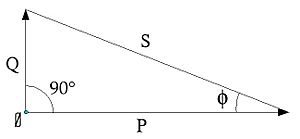Power factor facts for kids
In the world of electrical engineering, the power factor (often called PF or cosφ) is a way to measure how efficiently electric circuits use power. Think of it as a ratio between the power that actually does useful work (called real power) and the total power supplied to the circuit (called apparent power).
The power factor is calculated by dividing the real power (P) by the apparent power (S):
The power factor is always a number between zero and one. A higher power factor means the circuit is more efficient. This is because more of the electricity supplied is being used for its intended purpose, like running a motor or lighting a bulb. If the power factor is low, it means a lot of the power is wasted or not used effectively.
Why is Power Factor Important?
A good power factor is important for several reasons:
- Less wasted energy: When the power factor is close to one, less energy is lost as heat in the wires. This saves electricity.
- Lower electricity bills: For large businesses, a low power factor can mean higher electricity bills because they are charged for the total power supplied, not just the useful power.
- Better equipment performance: Electrical equipment works better and lasts longer when the power factor is good.
What Causes a Low Power Factor?
A power factor less than one usually happens because of certain types of electrical equipment. These are often called "non-linear loads." The main culprits are:
- Inductive loads: These are common in things like electric motors, transformers, and fluorescent lights. They create magnetic fields that cause the current to "lag" behind the voltage.
- Capacitive loads: Less common in homes but found in industrial settings, these include things like capacitor banks. They cause the current to "lead" the voltage.
Both inductive and capacitive loads can make the power factor less than one, meaning some of the electrical power isn't doing useful work.
Images for kids
-
1. Reactive power control relay; 2. Network connection points; 3. Slow-blow fuses; 4. Inrush-limiting contactors; 5. Capacitors (single-phase or three-phase units, delta-connection); 6. Transformer (for controls and ventilation fans)
See also
 In Spanish: Factor de potencia para niños
In Spanish: Factor de potencia para niños







